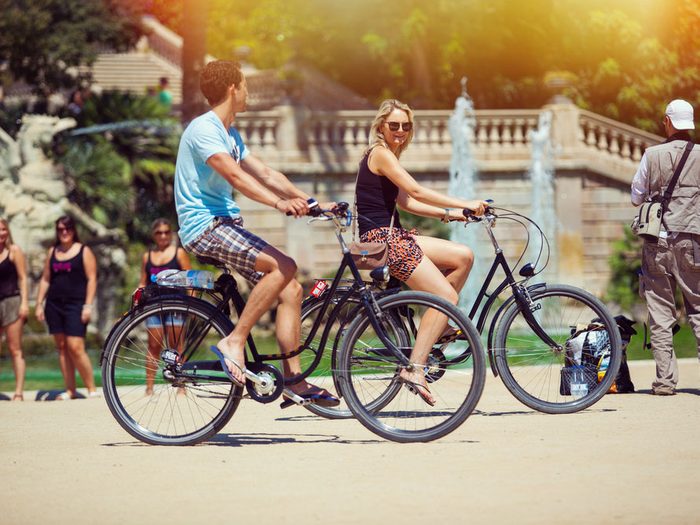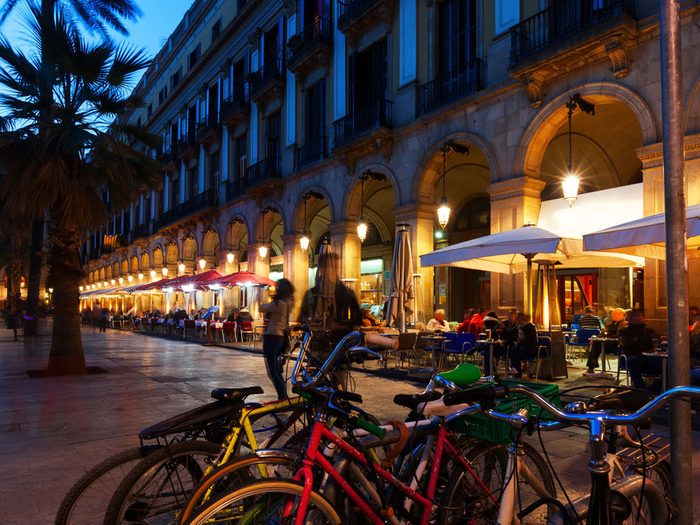1. That old cliché “it’s like riding a bike”? It exists for a reason.
When my friends suggested we book a bike trip across the Catalunyan coast in Spain last spring, my first suggestion was that I meet up with them in Barcelona at the end for the Tour de Tapas segment of the journey. Though I’m in pretty good shape, I hadn’t been on a bicycle since high school.
But FOMO (and the promise of Dali and cava, two things for which Spain’s northeast coast is known) won out, and I soon found myself snapping a helmet onto my carry-on bag. Here are 10 things I learned on my European bike tour.
When I admitted to my friend Amy a few weeks before our departure how long it had been since I’d been on two wheels, she barely hid her nervousness. Leading up to the trip, she beseeched me in text messages to get on a bike “just for five minutes” – a request I ignored. Her face showed pure panic when we got fitted with our equipment our first evening in Spain and I wobbled up our steep hotel driveway testing out my bike legs (confession: I was feeling some panic myself).
But it’s been scientifically proven that our bodies never forget how to ride a bicycle, something I quickly experienced firsthand. Well before we hit our first medieval village, about 13 leisurely kilometres of biking in, it was clear any fears were unfounded.
2. There’s no shame in walking uphill.
Our Exodus Travels tour was described as a level one, no biking experience required. That doesn’t mean it was easy riding all the way – though Catalunya has wide, flat rice fields, the roads close to the sea or headed up to some of the medieval villages are pretty steep. While we cheered each other on trying to climb each hill, we also didn’t judge if one of us (surprisingly not always I) had to hop off her bike and walk it up.
3. Still, it’s worth cross-checking your route before you go.
That being said, you can avoid hilly surprises by cross-checking the route against an elevation map before you book your trip. Our on-the-ground facilitators in Spain had previously run Exodus’s Tuscany itinerary, billed as a level three. Given the region’s hilly landscape, they said many people found it more challenging than expected.
4. You don’t have to be a joiner.
Self-guided tours such as the one I did straddle the middle ground between the logistical ease you get with a group trip and the flexibility of independent travel. Exodus handled all of the arrangements – including accommodations (one of our hotels was a restored 14th Century castle), luggage transfers, bikes and detailed route maps – but we biked and toured unescorted.
5. You’ll still have time to explore on foot (but check your itinerary!).
Bike trips don’t necessarily entail spending all your time on a bike. Our itinerary alternated travel days – where we had to get ourselves to a new hotel in a new town – with optional recommended routes for the days in between. When our “off day” put us a short walk from one of the region’s best beaches, we skipped the ride, strolled along the water for hours, and had a seafood feast steps from the sand for lunch. If time for exploring on your own is important to you, look for an itinerary that offers this flexibility.
Story continues on the next page.
6. You’ll enjoy the local food even more.
From the aforementioned seafood feast to tapas and Michelin-starred molecular cuisine, there is a lot of good eating to be had in Catalunya. Being constantly active ensured we could work up enough of an appetite to enjoy it all.
7. Actually, you’ll enjoy the whole destination more.
Cruising along country roads and through fields bearing the region’s famous Pals rice, we could smell warm soil, wildflowers, and feel soft breezes against our faces. Touring by bus or car can limit your perceptions of a destination but a bike allows you to experience a place with all of your senses.
8. Bike trips can test – and strengthen – your friendships.
They say you learn a lot about people when you travel with them. You learn even more when you travel with them by bike. In our case, things got dicey around differences in navigational style. I relied on GPS maps while my friend Sarah preferred to go by the detailed route notes we were provided; let’s just say the two didn’t always agree. But whatever bickering that occurred roadside was usually something we were already laughing about by the time we watched the sunset that day, glasses of local cava in hand.
9. You’ll come home rested – but also feeling like you’ve actually done something.
To me, vacation is generally an either or proposition: either I return blissfully relaxed after doing absolutely nothing on a beach or I hit all of the attractions on my list and come home more exhausted than I left. But plenty of fresh air and at least five hours of biking a day are pretty much a guaranteed formula for a great sleep (we passed out by 10 most nights), so I arrived home feeling both rested and like I’d accomplished something big.
10. It might be the start of a whole new way to travel.
Though I’m active at home, my bike trip was the first time I ever made fitness a central part of a trip. If I do work out on the road, it’s typically in a hotel gym. But with everything I learned in Spain, I’ve made more time for hiking, kayaking and other outdoor activities during my travels. I’ve even tried trail riding and took a bike tour on a recent California trip. It’s safe to say there won’t be another 20-year gap before I’m back on two wheels again.


